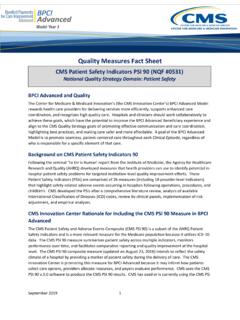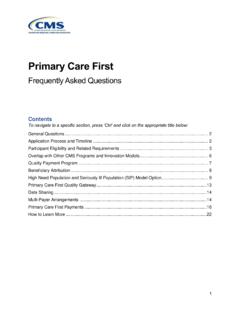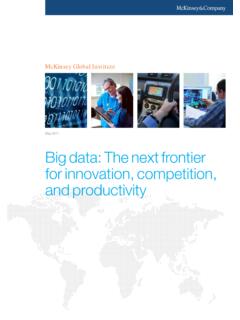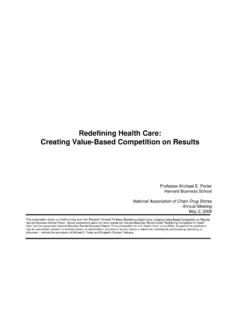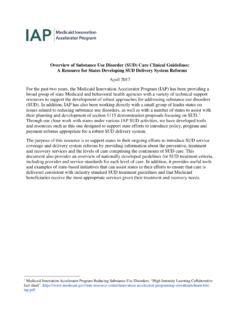Transcription of of Medical Things - Deloitte
1 Medtech and the Internet of Medical ThingsHow connected Medical devices are transforming health careJul y 2018 ContentsForeword 01 Executive summary 02 Part 1. Connectivity is transforming the medtech industry 08 Part 2. Challenges and opportunities for medtech 16 Part 3. Connected Medical devices are transforming care 31 Part 4. The future for medtech and the IoMT 40 Appendix: Nomenclature and Medical device classifications used in the report 47 Endnotes 48 Contacts 52 Deloitte Centre for Health SolutionsThe Deloitte Centre for Health Solutions is the research arm of Deloitte LLP s Life Sciences and Health care practices. Our goal is to identify emerging trends, challenges, opportunities and examples of good practice, based on primary and secondary research and rigorous UK Centre s team of researchers seeks to be a trusted source of relevant, timely and reliable insights that encourage collaboration across the health value chain, connecting the public and private sectors, health providers and purchasers, patients and suppliers.
2 Our aim is to bring you unique perspectives to support you in the role you play in driving better health outcomes, sustaining a strong health economy and enhancing the reputation of our this publication, references to Deloitte are references to Deloitte LLP, the UK affiliate of Deloitte NWE LLP, a member firm of Deloitte Touche Tohmatsu to the Deloitte Centre for Health Solutions report Medtech and the Internet of Medical Things : How connected Medical devices are transforming health care . Patient interactions with the health care system often involve interactions with equipment and devices from syringes and bandages, blood pressure monitors and pregnancy testing kits, to surgical instruments, pacemakers, artificial joints, and MRI and CT scanners. The Medical technology (medtech) industry designs and manufactures a wide range of products to diagnose, monitor, and treat patients and is instrumental in helping health care organisations achieve better patient outcomes, lower health care costs, improved efficiency and new ways of engaging and empowering patients.
3 Major advances in wireless technology, miniaturisation and computing power are driving innovation in medtech, leading to the development of an increasing number of connected Medical devices that are able to generate, collect, analyse and transmit data. The data, along with the devices themselves, are creating the Internet of Medical Things (IoMT) a connected infrastructure of Medical devices, software applications and health systems and services. The IoMT is rapidly transforming medtech s role and relationships within health care . More specifically, connectivity between sensors and devices is enabling health care organisations to streamline their clinical operations and workflow management, and improve patient care , even from remote locations. Provided medtech companies can convince clinicians and patients of the value and benefits of connected Medical devices, the pace and scale of health care transformation will be regulations, digitisation, data analytics, artificial intelligence, automation and the development of value-based health care represent some of the numerous challenges as well as opportunities facing the medtech industry.
4 Consequently, medtech companies from start-ups to corporates are reinventing themselves to remain competitive. New strategies are needed to harness data provided by digitally-enabled products and make their business and operating models relevant and sustainable. This will help companies develop evidence of better health outcomes at reasonable cost to obtain price reimbursement and gain market access. For some medtech companies this means shifting from a product-based model to a value-based system driven by software-based services and Medical devices will have a profound impact on patients, clinicians and the life sciences industry. Our report focuses on how the IoMT is transforming medtech s role in health care and the impact of the increased use of connected Medical devices on medtech companies business and operating models. It outlines how medtech companies can get digital transformation right whether through adapting their existing business models, inventing new ones or both.
5 The industry s future will depend on its ability to demonstrate to providers and payers how connected Medical devices contribute to the new value-based RontePartner Monitor Deloitte Karen TaylorDirector Centre for Health Solutions John HaugheyLead partner UK and North West Europe01 Medtech and the Internet of Medical Things | How connected Medical devices are transforming health careExecutive summaryA series of technological and cultural revolutions are allowing technology and people to be better connected to one another, leading to the development of the Internet of Things (IoT) a network of connected, smart devices and objects that can communicate with each other and automate key tasks. Medical technology (medtech) companies manufacture more than 500,000 different types of Medical devices, including wearable external Medical devices (skin patches, insulin pumps and blood glucose monitors), implanted Medical devices (pacemakers and implantable cardioverter defibrillator devices) and stationary Medical devices (home monitoring devices, connected imaging devices and scanning machines).
6 Most patient interactions with the health care system involve the use of Medical equipment and most other industries, the health care sector is increasingly realising the transformative nature of IoT technologies, as advances in computing and processing power, wireless technology and miniaturisation drive innovation in connected Medical device development. Connectivity enhancement can be applied to most categories of Medical devices. The rise in the numbers of connected Medical devices, together with advances in the systems and software that support the capture and transmission of Medical grade data, connectivity technologies and services, have created the Internet of Medical Things (IoMT). The IoMT brings together the digital and physical worlds to improve the speed and accuracy of diagnosis and treatments, and monitor and modify patient behaviour and health status in real time. It also improves health care organisations operational productivity and effectiveness by streamlining clinical processes, information and work flows.
7 Connectivity between sensors and devices aids real-time patient care , even from remote locations, while improving communication within and between Medical facilities. The large volume of data generated creates opportunities for new models of care and supports the delivery of 4P medicine medicine that is predictive, preventive, personalised and IoMT brings together people (patients, caregivers and clinicians), data (patient or performance data), processes ( care delivery and patient support) and enablers (connected Medical devices and mobile applications) to deliver improved patient outcomes efficiently. While the IoMT has the potential to help alleviate some of the cost, access and care coordination challenges facing health care , the generation of data points through millions of connected Medical devices will have little impact unless data can be turned into actionable specifically, connected Medical devices are a key enabler across the six predictions in our report The future awakens: Life sciences and health care predictions 2022.
8 The extent to which the predictions are realised is heavily dependent on the continued innovation and adoption of connected Medical devices at valued the IoMT market at $ billion in 2017 and expects it to rise to $ billion in 2022. The connected Medical devices segment (helping to diagnose, monitor and treat patients) of the IoMT is expected to rise from $ billion in 2017 to $ billion by 2022. The rise of the IoMT comes at a time when health care is becoming increasingly expensive, with global health care spending expected to grow per cent per year, from $ trillion in 2015 to $ trillion by 2020, largely due to a growing and ageing population, with more people living longer but with multiple comorbidities. As a result, without radical transformation, health care in many countries risks becoming increasingly medtech industry has an important role to play in helping to reduce costs, improve the quality and efficiency of care and support the shift to value-based care (VBC).
9 However, the industry also faces a number of systemic challenges and opportunities that need to be addressed for the full value of the IoMT to be realised. These include: Developing an in-depth understanding of end users as more providers adopt VBC models, the speed of adoption and integration of connected Medical devices will increase. Data and insights on patients and processes is key to VBC. Challenges include the extent to which an organisation s IT infrastructure is able to handle or process the connections and data, and whether clinicians and patients can be convinced of the safety and effectiveness of the devices. Medtech companies need 02 Medtech and the Internet of Medical Things | How connected Medical devices are transforming health careto develop a deep understanding of the end-user and create business models and scenarios that demonstrate how their new and existing devices not only improve patient outcomes but also create value for key health care stakeholders.
10 Developing new funding, business and operating models as health care organisations focus more on improving quality and reducing the costs of providing care , they require medtech companies to demonstrate greater evidence on the added value of both new and enhanced products. We commissioned a survey that found that medtech companies are having mixed results in demonstrating the value of their connected Medical devices, although some are engaged in providing services rather than just products. Different types of innovation will require different business models, and progress will depend on both the innovators themselves working in new ways to take on risks and rewards, and the evolution of existing payment systems by both public and private payers. Understanding interoperability requirements interoperability is arguably the biggest challenge for medtech, including complying with various national and international standards and protocols around the exchange and use of data.










